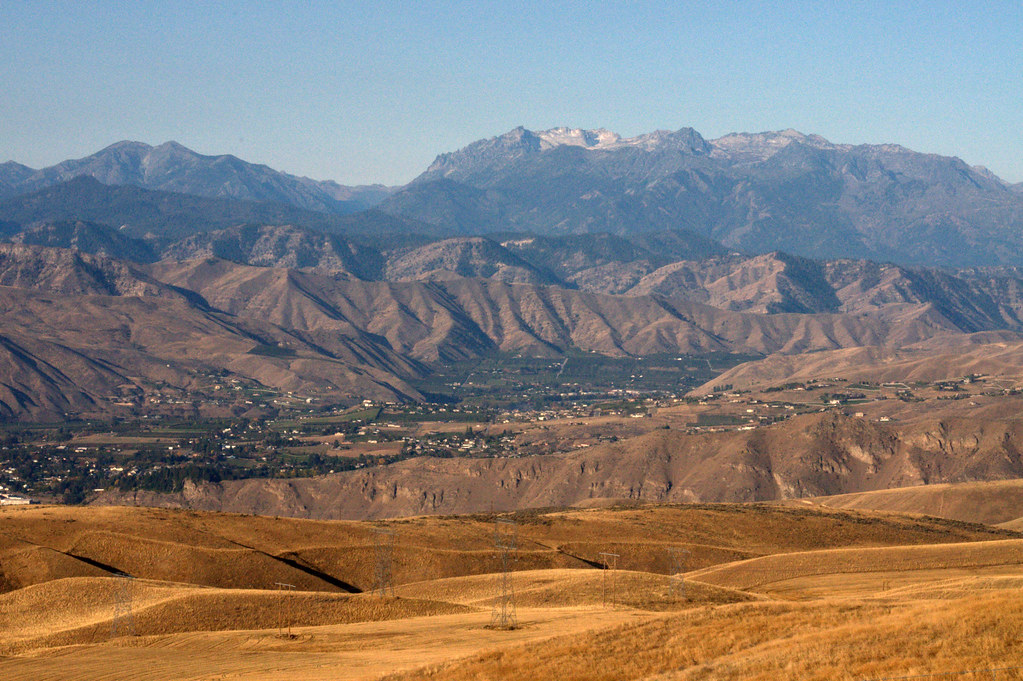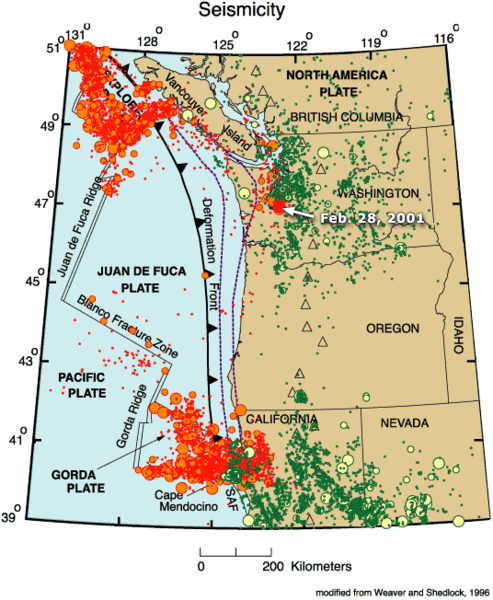The comments thread contains some questions and points of especial interest, which I shall take in order. But not before telling you all that I appreciate every comment and compliment more than I can ever express. Thank you!
Suzanne says my blog has now taught her enough that she can recognize some features and formations. This, I have to say, is one of the most rewarding comments I've ever received here. Then again, she's one of the most rewarding people I know. I'm glad I can give her something of some worth in return for all she's given to me!
Karen's anecdote is a shining example of how you can tell a geologist from a non-geologist. Geologists (and geology buffs) are the ones who get super-excited over the seemingly-dull rocks when something shiny and valuable is also present. You can be certain you've identified a geologist if they wax enthusiastic over the phyllite and then suggest everybody go for a beer.
George A posts the following photo and question:
 |
| Wenatchee, Ridge View, by George. Do not filch this photo like I did because it's All Rights Reserved. |
ZOMG that's tasty. I'll have to head out there. Alas, it appears George's host was mistaken. The Juan de Fuca plate currently ends at the Cascadia Subduction Zone, which is offshore:We stayed in East Wenatchee on a visit to Washington last year. Our host told me that the mountains in the background of the linked picture are on the Juan de Fuca, while the nearer ones are on the NA plate. I gather from this post that he is correct?
 |
| Filched from Wikipedia. It's a USGS image, so we technically paid for it anyway. |
The heavy black line with arrows in that looks rather like very somber bunting marks the subduction zone. You can tell from the seismic activity that it has influence far inland, but no, those mountains and hills aren't actually on the Juan de Fuca plate. They belong to the North American plate, now. They didn't always. I'd have to do quite a lot more reading up before I could speak with any confidence as to the details, but basically, North America's been filching from the Kula and Farallon (and now Juan de Fuca) for many millions of years. What you see in Wenatchee did indeed once belong to another plate, but it's solidly North American now.
Ron Blakey has some very good paleomaps that give an idea of how insane this region is. Here's one of North America ca 50 million years ago, and one showing some hot terrane action. I also found this University of Alabama site, with a wonderful geologic map and a nice write-up of some of the areas you likely were in.
Right. There's something of an answer, and any geologists with knowledge of Wenatchee should feel free to pile on in comments.
Nick suggests Northwest Exposures and Roadside Geology of Washington. As do I, without reservation. I have got them both sitting beside me as we speak, in fact.
Bra says, " If I had it to do all over again, I'd be a linguist instead, but if I had to do over TWICE, I'd be a geologist!" Strangely enough, so would I... I almost went back to school for a degree in linguistics before I decided my time would be better spent writing, and just lately, I've had a hankering to get a geology degree. Alas, little time and absolutely no money.
Christian Renggli believes one of my unidentified rocks is a migmatite, and after looking at examples on the Wikipedia page, I have to say I believe he's on to something. Nicely done! You see, this is why I love my readers. Well, one of a great many reasons. Anyway, I found lots more where that came from, so perhaps a post on migmatites is in order, once I've read up on them. Suggestions?
Shane Evans has a good question:
The answer, simply, is yes. Mica schist would be next on the list had the heat and pressure stayed on. The more complex answer has to do with Barrovian metamorphism, which is a fascinating topic in its own right and one I should also research more deeply. One o' these days, I'll have visited the entire sequence from shale to gneiss, and then we shall have a proper treatment of the subject, complete with delicious photos.Thanks for the info on phyllite! It was new to me. Would a bit more squeezing make it schist? Just wondering.
And, finally, SocialMike has some comments on the economics of subduction zones that would repay a perusal.
Now on to the request for expert assistance: my soon-to-be-coblogger would like to know more about the geology of the Cascades as seen from Seattle, specifically the bit in the middle-right of this photo that sticks up like a cock's comb. The one book I have that gets into the specifics of Cascades geology focuses only on the bits to the north of Seattle, so I'm at a loss. Anyone got the answer?
That, I have to say, was a lot of fun. We should do this more often. Consider this an open thread. Pitch your questions, comments, observations, and bad geology puns, and we shall have another in the very near future.







3 comments:
I'd like to return to school for geology, specifically seismology/geophysics. I have a BA (in geography). Would going for a second bachelors be more useful? I don't know if any Masters programs would accept me right away--I'm lacking in the hard sciences.
-terry
I think that's Mt. Index.
@Terry: You know, I don't know. No degree meself. I'll keep this one for the next post I do up w/questions and requests, and see if one of the professional geos knows the answer.
@Cujo I think you're right. Excellent find!
Post a Comment